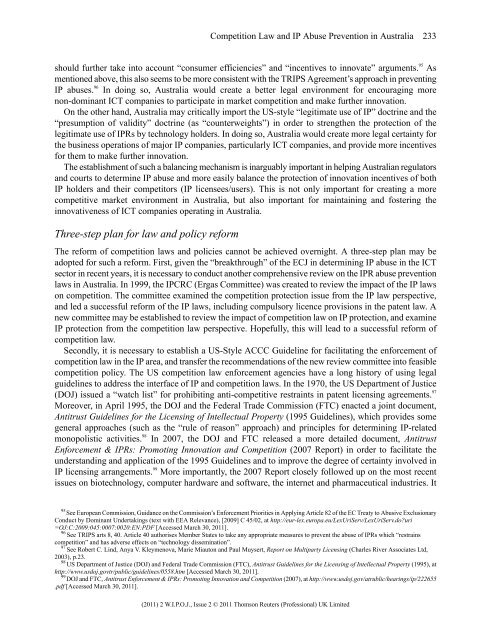WIPO Journal - World Intellectual Property Organization
WIPO Journal - World Intellectual Property Organization
WIPO Journal - World Intellectual Property Organization
You also want an ePaper? Increase the reach of your titles
YUMPU automatically turns print PDFs into web optimized ePapers that Google loves.
should further take into account “consumer efficiencies” and “incentives to innovate” arguments. 95 As<br />
mentioned above, this also seems to be more consistent with the TRIPS Agreement’s approach in preventing<br />
IP abuses. 96 In doing so, Australia would create a better legal environment for encouraging more<br />
non-dominant ICT companies to participate in market competition and make further innovation.<br />
On the other hand, Australia may critically import the US-style “legitimate use of IP” doctrine and the<br />
“presumption of validity” doctrine (as “counterweights”) in order to strengthen the protection of the<br />
legitimate use of IPRs by technology holders. In doing so, Australia would create more legal certainty for<br />
the business operations of major IP companies, particularly ICT companies, and provide more incentives<br />
for them to make further innovation.<br />
The establishment of such a balancing mechanism is inarguably important in helping Australian regulators<br />
and courts to determine IP abuse and more easily balance the protection of innovation incentives of both<br />
IP holders and their competitors (IP licensees/users). This is not only important for creating a more<br />
competitive market environment in Australia, but also important for maintaining and fostering the<br />
innovativeness of ICT companies operating in Australia.<br />
Three-step plan for law and policy reform<br />
The reform of competition laws and policies cannot be achieved overnight. A three-step plan may be<br />
adopted for such a reform. First, given the “breakthrough” of the ECJ in determining IP abuse in the ICT<br />
sector in recent years, it is necessary to conduct another comprehensive review on the IPR abuse prevention<br />
laws in Australia. In 1999, the IPCRC (Ergas Committee) was created to review the impact of the IP laws<br />
on competition. The committee examined the competition protection issue from the IP law perspective,<br />
and led a successful reform of the IP laws, including compulsory licence provisions in the patent law. A<br />
new committee may be established to review the impact of competition law on IP protection, and examine<br />
IP protection from the competition law perspective. Hopefully, this will lead to a successful reform of<br />
competition law.<br />
Secondly, it is necessary to establish a US-Style ACCC Guideline for facilitating the enforcement of<br />
competition law in the IP area, and transfer the recommendations of the new review committee into feasible<br />
competition policy. The US competition law enforcement agencies have a long history of using legal<br />
guidelines to address the interface of IP and competition laws. In the 1970, the US Department of Justice<br />
(DOJ) issued a “watch list” for prohibiting anti-competitive restraints in patent licensing agreements. 97<br />
Moreover, in April 1995, the DOJ and the Federal Trade Commission (FTC) enacted a joint document,<br />
Antitrust Guidelines for the Licensing of <strong>Intellectual</strong> <strong>Property</strong> (1995 Guidelines), which provides some<br />
general approaches (such as the “rule of reason” approach) and principles for determining IP-related<br />
monopolistic activities. 98 In 2007, the DOJ and FTC released a more detailed document, Antitrust<br />
Enforcement & IPRs: Promoting Innovation and Competition (2007 Report) in order to facilitate the<br />
understanding and application of the 1995 Guidelines and to improve the degree of certainty involved in<br />
IP licensing arrangements. 99 More importantly, the 2007 Report closely followed up on the most recent<br />
issues on biotechnology, computer hardware and software, the internet and pharmaceutical industries. It<br />
95<br />
See European Commission, Guidance on the Commission’s Enforcement Priorities in Applying Article 82 of the EC Treaty to Abusive Exclusionary<br />
Conduct by Dominant Undertakings (text with EEA Relevance), [2009] C 45/02, at http://eur-lex.europa.eu/LexUriServ/LexUriServ.do?uri<br />
=OJ:C:2009:045:0007:0020:EN:PDF [Accessed March 30, 2011].<br />
96<br />
See TRIPS arts 8, 40. Article 40 authorises Member States to take any appropriate measures to prevent the abuse of IPRs which “restrains<br />
competition” and has adverse effects on “technology dissemination”.<br />
97<br />
See Robert C. Lind, Anya V. Kleymenova, Marie Miauton and Paul Muysert, Report on Multiparty Licensing (Charles River Associates Ltd,<br />
2003), p.23.<br />
98<br />
US Department of Justice (DOJ) and Federal Trade Commission (FTC), Antitrust Guidelines for the Licensing of <strong>Intellectual</strong> <strong>Property</strong> (1995), at<br />
http://www.usdoj.govtr/public/guidelines/0558.htm [Accessed March 30, 2011].<br />
99<br />
DOJ and FTC, Antitrust Enforcement & IPRs: Promoting Innovation and Competition (2007), at http://www.usdoj.gov/atrublic/hearings/ip/222655<br />
.pdf [Accessed March 30, 2011].<br />
Competition Law and IP Abuse Prevention in Australia 233<br />
(2011) 2 W.I.P.O.J., Issue 2 © 2011 Thomson Reuters (Professional) UK Limited

















